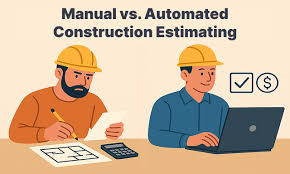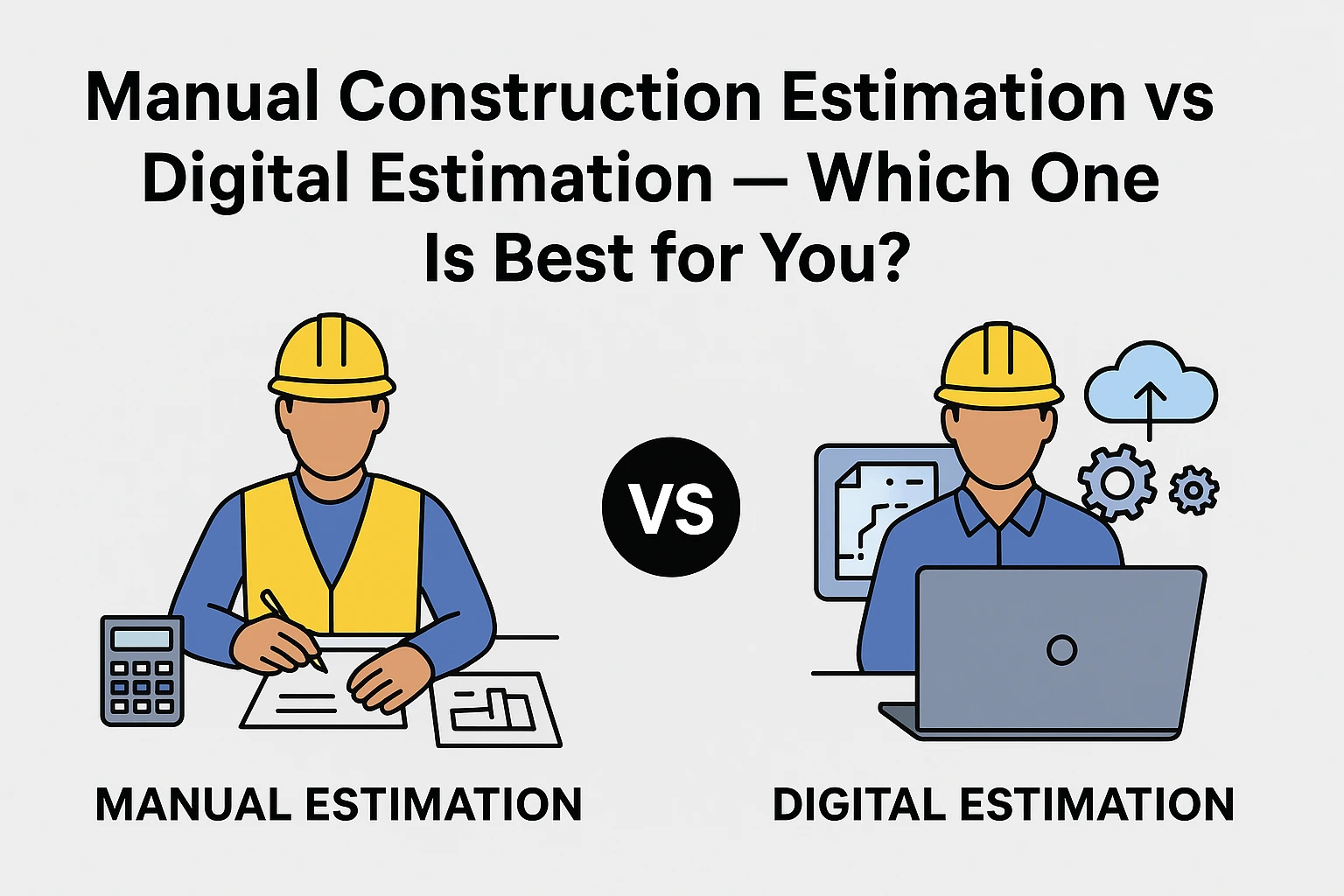Manual vs Digital Construction Estimation
| Factor | Manual Estimation | Digital Estimation |
| Accuracy | Depends on experience | Highly accurate, automated |
| Speed | Slow | Fast and efficient |
| Cost | Low upfront | Higher upfront, better ROI |
| Scalability | Limited | Easily scalable |
| Collaboration | Difficult | Seamless, real-time |
| Learning Curve | Easy | Requires training |
| Risk Management | Human-dependent | Data-driven, traceable |
| Best for | Small/simple projects | Medium-large, complex projects |
When it comes to planning a project, the accuracy of your estimates can make or break your success. Whether you’re managing construction, manufacturing, or even marketing budgets, estimation is the backbone of every decision. For years, professionals relied on manual methods — calculators, spreadsheets, and experience. But now, with the rise of software and automation, digital estimation is transforming how businesses work.
So, the real question is: Manual estimation vs digital estimation — which one is best for you?
Table of Contents
The Basics — What’s the Difference?
Manual Estimation
Manual estimation is the traditional way of working. It relies on human judgment, experience, and simple tools like paper, pen, or Excel sheets. Estimators calculate quantities, materials, and costs manually — often double-checking figures and adjusting based on intuition or past projects.
Example: In manual construction estimator might review blueprints, measure dimensions, and manually calculate concrete volume or steel weight before preparing a quote.
Digital Estimation
Digital estimation, on the other hand, uses specialized software or cloud-based tools. These platforms automate quantity takeoffs, integrate cost databases, and even simulate project timelines. Digital systems don’t replace human skill — they enhance it by speeding up tasks, improving precision, and reducing errors.
Example: Using software like PlanSwift, Bluebeam, or an estimator can upload drawings, run automated measurements, and generate complete cost reports within minutes.
Speed and Efficiency — Manual Effort vs Machine Power
Manual Estimation
Manual work takes time. From collecting data to cross-checking figures, estimators can spend hours on what digital systems finish in minutes. Every revision or client change means starting again, recalculating, and rewriting.
Digital Estimation
Digital tools shine in speed. They allow users to edit quantities, apply updated prices, or share files instantly. Cloud access means your whole team can collaborate without wasting time emailing spreadsheets back and forth.
Verdict: If you’re managing multiple projects or facing tight deadlines, digital estimation easily wins on speed.
Accuracy — The Human Touch vs Automated Precision
Manual Estimation
Manual methods depend heavily on experience. Skilled estimators can produce accurate results — but they’re still human. Fatigue, distraction, or data entry errors can easily cause costly mistakes. One wrong cell in a spreadsheet might throw off an entire quote.
Digital Estimation
Software drastically reduces arithmetic and measurement errors. Tools automatically check for inconsistencies, flag missing data, and update linked quantities in real time. Still, accuracy depends on the data you input — “garbage in, garbage out” remains true.
Verdict: Digital estimation offers higher accuracy and consistency, especially for complex or large-scale projects.
Cost and Investment — Upfront Expense vs Long-Term Savings
Manual Estimation
The upfront cost is minimal — you only need basic tools and time. But in the long run, manual methods can cost more through inefficiency, errors, and slow turnaround. Missing a project deadline or underbidding due to a miscalculation can be far more expensive than buying software.
Digital Estimation
Digital systems do have initial costs — software licenses, training, and possibly new hardware. But they pay off with faster turnaround times, better bid accuracy, and the ability to handle more projects with fewer resources.
Verdict: Manual is cheaper to start, but digital estimation offers stronger returns on investment over time.

Scalability — Staying Small or Growing Big
Manual Estimation
Great for smaller operations or one-off projects. If you only handle a few estimates a month, manual methods may be enough. But as your business grows, manual work becomes a bottleneck. Managing multiple files, versions, and updates gets messy fast.
Digital Estimation
Designed for scalability. Whether you manage one project or a hundred, digital tools can handle it. Cloud storage, templates, and automation allow you to scale up without multiplying your workload.
Verdict: If growth and volume are part of your future, digital estimation is the smarter path.
Collaboration and Accessibility — Solo Effort vs Team Workflow
Manual Estimation
Manual systems usually live on one computer — or worse, in one person’s notebook. Sharing updates, tracking changes, or working remotely becomes difficult. Collaboration often means version confusion (“Which file is final_v3?”).
Digital Estimation
Modern digital tools allow multiple users to view, comment, and edit simultaneously. Everything is stored securely online, so you can access data anywhere — office, site, or home. It also supports transparency between teams and clients.
Verdict: Digital estimation wins for collaboration, especially in multi-team or remote settings.
Learning Curve — Comfort vs Change
Manual Estimation
Many professionals prefer manual methods simply because they’re familiar. No new software, no updates, no training required. For experienced estimators, it feels faster because they know the process inside out.
Digital Estimation
The biggest barrier to adopting digital tools is often the learning curve. Software requires setup and training. But once mastered, it’s significantly more efficient and future-ready.
Verdict: Manual is easier short-term, but digital skills pay off long-term.
Risk and Reliability — Trusting People vs Trusting Systems
Manual Estimation
Human oversight means flexibility — you can make judgment calls and adjustments. However, that flexibility can also mean inconsistency and potential for bias.
Digital Estimation
Systems provide a standardized process, ensuring every project follows the same method. You can track revisions, maintain audit trails, and rely on data rather than memory.
Verdict: Digital estimation minimizes risk and enhances reliability, particularly in regulated or high-value industries.
When Manual Estimation Still Makes Sense
Despite digital advantages, manual estimation still has its place.
You might prefer manual if:
- Your projects are small and simple.
- You rely on niche expertise not easily captured by software.
- You don’t have budget or infrastructure for digital tools.
- You value personal oversight more than speed.
Manual estimating is like driving a classic car — slower, but some professionals love the control it gives.
When Digital Estimation is the Smarter Move
Digital estimation fits perfectly when:
- You handle frequent or large-scale projects.
- You need detailed, data-driven reports.
- Collaboration and remote work are part of your operations.
- You want faster turnaround and fewer errors.
- You plan to scale or compete in bigger markets.
Think of digital estimation as upgrading to a modern, automated vehicle — it takes you further, faster, and with fewer surprises on the road.
Hybrid Approach — The Best of Both Worlds
Many successful companies combine both approaches. Estimators use software for data collection and cost breakdowns but still apply manual judgment for unique project details. This hybrid approach keeps the precision of digital tools and the wisdom of human experience.
If you’re transitioning from manual to digital, start small — use software for repetitive tasks and keep oversight manual until your team gains confidence. Gradually, automation will become second nature.
So ask yourself
- Do I value control and simplicity, or do I need speed and scale?
- Can I afford to stay manual while competitors automate?
Your answer will decide which road leads to your success.
If you’re a freelancer or small firm handling occasional projects, manual may still be enough.
But if you’re bidding competitively, managing multiple projects, or aiming for growth, digital estimation is the future.
Final Thoughts — Manual estimation vs digital construction estimation
Manual estimation built the foundation of countless successful projects — it’s where experience meets intuition. But the pace of today’s market demands speed, data accuracy, and collaboration that only digital estimation can deliver.
In 2025 and beyond, the best estimators will blend technology with human insight. The real winners won’t be those who choose one over the other — but those who learn to use both wisely.

